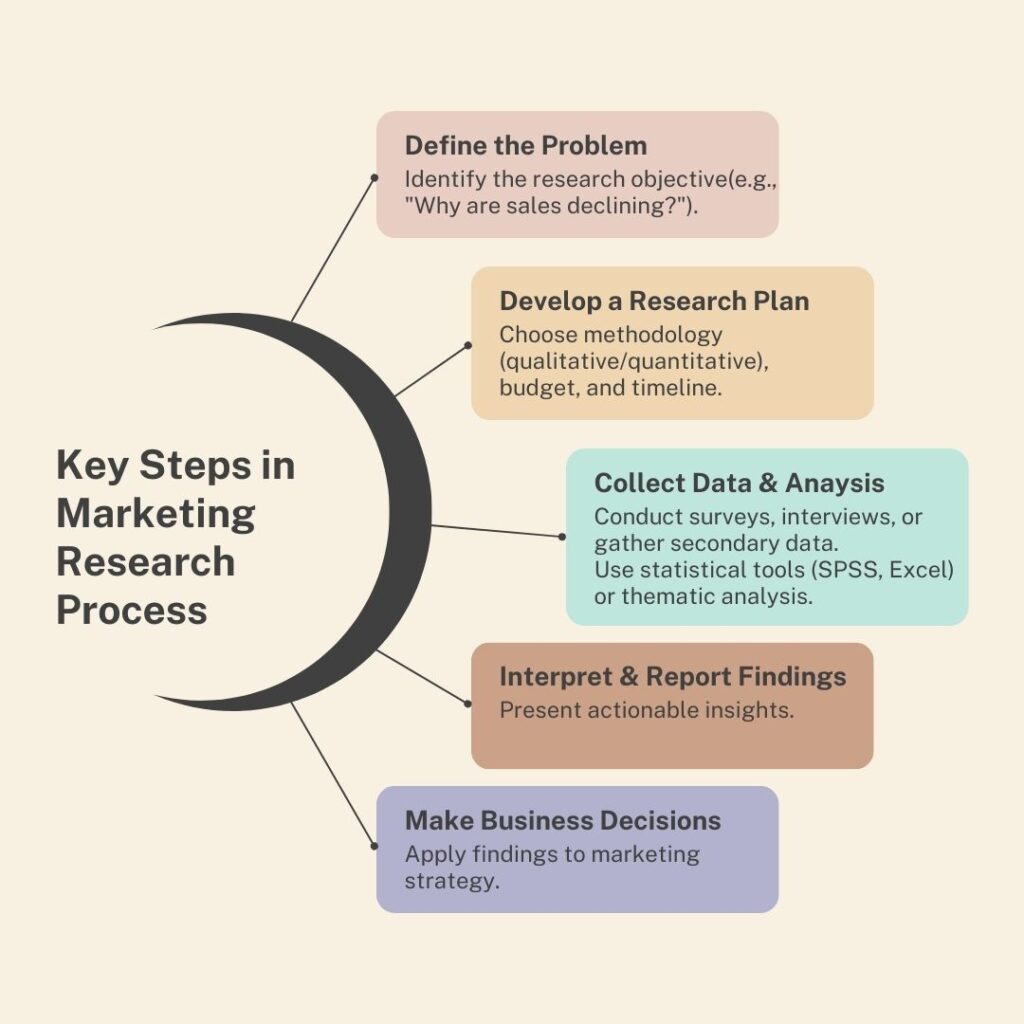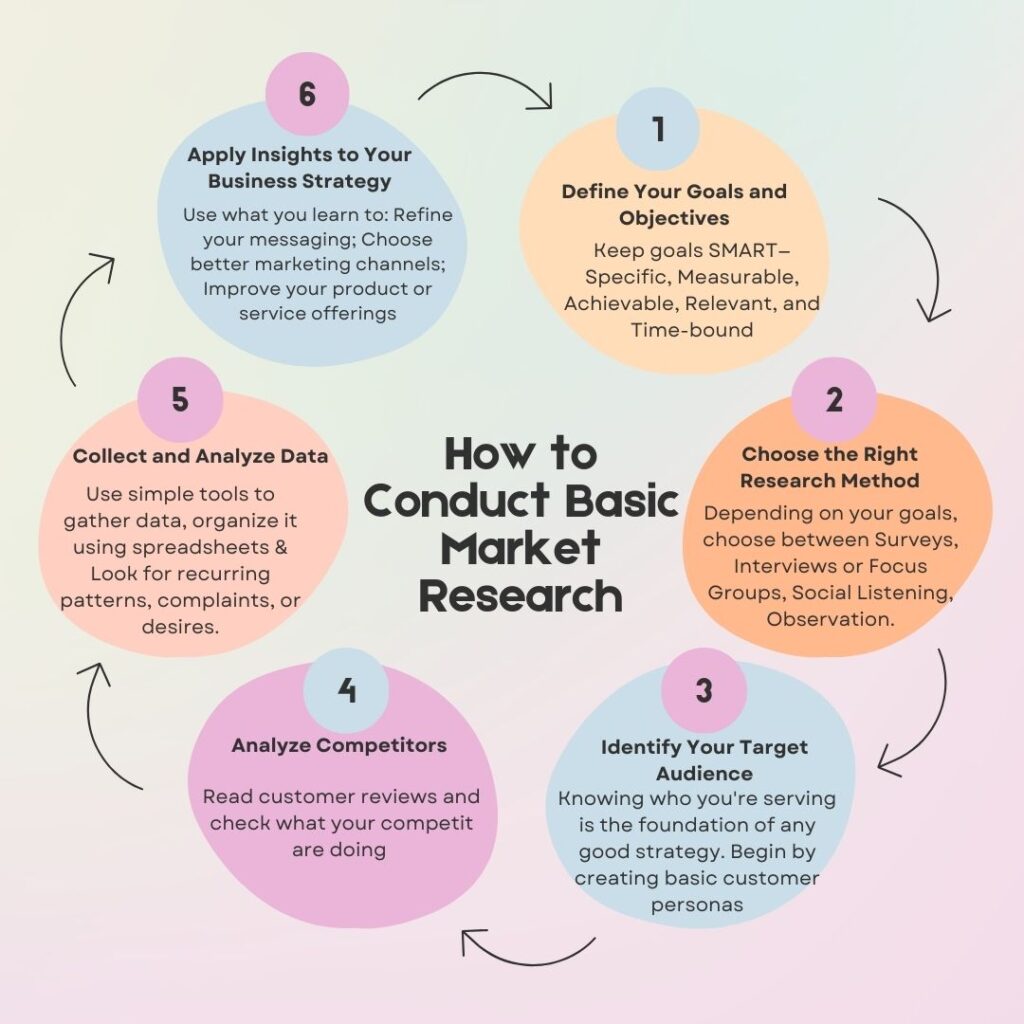If you’re a solopreneur, small business owner, or new digital marketer struggling to make confident decisions, this Market Research for Beginners guide is exactly what you need. Too many businesses waste time and money chasing the wrong audience or offering products no one asked for. Why? They skip the research. That guesswork leads to missed opportunities, poor sales, and marketing misfires. But here’s the good news: effective market research isn’t just for big brands—it’s accessible, actionable, and essential. In this post, you’ll get a step-by-step guide to smarter business decisions using simple, beginner-friendly research techniques that drive real results.
What is Market Research & Why Does It Matter?
Market research is the systematic process of gathering, analyzing, and interpreting data about:
- Your target customers (needs, preferences, behaviors)
- Your competitors (strengths, weaknesses, strategies)
- Your industry (trends, opportunities, threats)
For beginners, it’s not about complex analytics or hiring pricey consultants. It’s about understanding your customers and making informed decisions. Without research, you’re flying blind. With it, you can craft laser-focused marketing, identify profitable niches, and avoid wasting resources.

Why Should You Care?
Many business ventures fail because they assume they know what customers want. Market research helps you:
✅ Reduce risk – Avoid launching products nobody wants.
✅ Find untapped opportunities – Discover gaps competitors miss.
✅ Optimize marketing – Speak directly to customer pain points.
✅ Stay ahead of trends – Adapt before your competitors do.
✅ Avoid guesswork – Make decisions based on real data.
✅ Understand your audience – Know what customers truly want.
✅ Beat competitors – Find gaps in the market.
✅ Save money – Test ideas before investing heavily.
Example:
A solopreneur wants to sell handmade skincare. Instead of guessing what customers want, they:
– Survey 50 people and learn that most want affordable, organic products.
– Analyze competitors and find none that offer subscription boxes.
– Result: They launch a monthly organic skincare box and succeed.
Types of Marketing Research:
- Primary: Involves collecting new data directly from sources. For example, Surveys, interviews, focus groups, Observational Research, and Experiments (A/B testing, product trials)
- Secondary: Uses existing data from external sources. For example, Government reports (e.g., Census data), Industry reports. Academic journals, Competitor websites & annual reports, social media & online forums, Industry reports, statistics, online articles
Top Free Sources
– Google Trends – See what’s trending in your niche.
– Statista – Industry statistics & reports (free basic access).
– Competitor Websites & Reviews– Learn from their customers.
How to Conduct Basic Market Research for Beginners: A Step-by-Step Guide for solopreneurs and small business owners.

Step 1: Define Your Goals and Objectives
Before diving into data collection, clarify why you’re doing market research. Ask yourself:
- What do I want to learn?
- Am I testing a product or service idea?
- Do I want to better understand my audience?
Having a clear purpose ensures you focus on gathering the right information and avoid analysis paralysis.
👉 Tip for beginners: Keep goals SMART—Specific, Measurable, Achievable, Relevant, and Time-bound
❌ Bad: “I want to know about my market.”
✅ Good: “I need to know if working moms aged 30-45 would buy my 10-minute meal planner.”
Step 2: Choose the Right Research Method
There’s no one-size-fits-all approach. Depending on your goals, choose between:
- Surveys (quantitative): Great for measuring preferences
- Interviews or Focus Groups (qualitative): Ideal for deep insights
- Social Listening: Monitor conversations on platforms like X (Twitter), Reddit, and Facebook groups
- Observation: Watch customer behavior in-store or online
As a beginner, start small. Even 5–10 honest responses can offer actionable insights.
| If You Need… | Use This Method |
|---|---|
| Quick opinions from many people | Surveys |
| Deep emotional insights | Interviews |
| Understanding market trends | Google Trends + industry reports |
| Real user behavior | Observational research |
Step 3: Identify Your Target Audience
Knowing who you’re serving is the foundation of any good strategy. Begin by creating basic customer personas that outline:
- Age, gender, location
- Interests and behaviors
- Pain points and motivations
Free tools like Google Analytics, Meta Audience Insights, and Think with Google can provide insights into your ideal customer.
Market Research for Beginners often fails here—trying to appeal to everyone. Instead, narrow your audience to the people most likely to buy from you.
How to Find Your Target Audience for Free:
- Facebook Groups – Search “[Your Niche] + Group”
- Reddit – Read threads in relevant subreddits
- Quora – See what questions people ask
Create a customer persona, Hubspot’s Free tools (a fictional profile of your ideal buyer).
📌 Download Free Template: Customer Persona Template
Step 4: Analyze Competitors (Even If You’re a Solopreneur)
3 Key Questions:
- What are they selling? (Product features, pricing)
- What are customers saying? (Read Amazon/Trustpilot reviews)
- Where are they marketing? (Instagram? YouTube? Blogs?)
Free Competitor Analysis Template:
| Competitor | Strengths | Weaknesses | Opportunity for Me |
|---|---|---|---|
| Competitor A | Great branding | Expensive | Offer a budget option |
Step 5: Collect and Analyze Data
Use simple tools to gather data:
- Google Forms or Typeform for surveys
- Ubersuggest and AnswerThePublic for keyword trends
- Google Trends for understanding market movement
Once data is collected, organize it using spreadsheets or dashboards. Look for recurring patterns, complaints, or desires.
The key in Market Research for Beginners is not perfection—it’s progress. Focus on trends that repeatedly surface rather than outliers.
Step 6: Apply Insights to Your Business Strategy
Research is only powerful when applied. Use what you learn to:
- Refine your messaging
- Choose better marketing channels
- Improve your product or service offerings
Example: A small bakery discovered through surveys that most customers wanted gluten-free options. They adjusted their product line and saw a 30% sales boost in three months.
Market Research for Beginners doesn’t need to be exhaustive—it just needs to inform decisions.
Common Market Research Mistakes to Avoid
Even well-intentioned beginners make missteps. Avoid these:
- Asking leading or biased questions
- Relying only on opinions from family/friends
- Ignoring qualitative feedback
- Collecting too much data without a clear direction
Keep your research simple, structured, and objective.
Top Tools and Resources for Market Research Beginners
Here are some beginner-friendly tools to start strong:
| Purpose | Tool |
|---|---|
| Surveys | Google Forms, Typeform |
| Competitor Analysis | Ubersuggest, SEMrush (free trial) |
| Audience Insights | Meta Business Suite, Google Analytics |
| Trend Discovery | Google Trends, Exploding Topics |
| Keyword Research | AnswerThePublic, KeywordTool.io |
Most of these have free plans, perfect for small budgets.
Conclusion: Start Smart with Market Research for Beginners
Market research doesn’t have to be overwhelming. As a solopreneur or small business owner, embracing even the basics of market research can dramatically improve your decision-making and results. This guide on Market Research for Beginners has given you the roadmap—from setting goals to applying insights—with practical tools to get started today.
Remember: Every smart business decision begins with understanding your audience. Don’t skip this step.
Key Takeaways
✔ Start small – Even a 5-question survey helps.
✔ Use free tools – Google Forms, Trends, Ubersuggest.
✔ Know your customer – Build a persona.
✔ Check competitors – Learn from their mistakes.
✔ Test before investing – Validate demand first.
Ready to take action?
👉 Download our free Market Research Starter Template to simplify your process and start collecting valuable insights today!


![Which All-in-One Marketing tool Is Right for You?Systeme.io vs. GoHighLevel [2025] Read more about the article Which All-in-One Marketing tool Is Right for You?Systeme.io vs. GoHighLevel [2025]](https://www.smartmarketingkits.com/wp-content/uploads/2025/04/Systeme.io-vs.-GoHighLevel-300x188.png)
![Mastering Marketing Mix Essentials for Small Business Success [2025] Read more about the article Mastering Marketing Mix Essentials for Small Business Success [2025]](https://www.smartmarketingkits.com/wp-content/uploads/2025/05/Marketing-Mix_4Ps-300x188.jpg)
![Beginner’s Guide to Keyword Research for Small Businesses and Solopreneurs [2025] Read more about the article Beginner’s Guide to Keyword Research for Small Businesses and Solopreneurs [2025]](https://www.smartmarketingkits.com/wp-content/uploads/2025/06/Beginners-Guide-to-Keyword-Research-300x188.jpg)